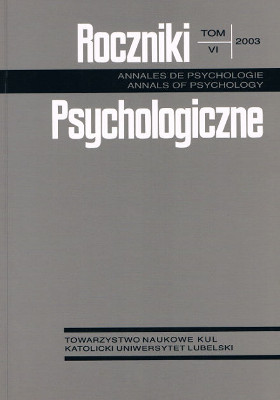Feature games: Presentation and psychological analysis of the phenomenon in H. Hermans's theory of valuation
Abstract
Participation in feature games is one of the manifestations of imaginary activity. It consists in creating fictive figures, which become partners of internal dialogues. Hubert Hermans's theory of valuation is a theoretical and methodological background for the research on this kind of phenomena. The theory belongs to the narrative trend in psychology.
The point of departure for the studies were the following questions: 1) relations between personality traits of the players and their experiences, and the properties and manner by which the experiences of their imagined figures were organized, 2) the importance of an imagined figure for the internal dynamism of the self. Fifteen participants of the feature games have been tested by means of H. Hermans's Method of Confrontation with Self and Adjective Check List by H. G. Gough and A. B. Heilbrun. Thus obtained idiographic material allows us to conclude that the imagined person is a separate, although linked with the „self” of a person, centre of organization in self, and is an opportunity to explore new kinds of experience.
References
Berne, E. (1987). W co grają ludzie? Psychologia stosunków międzyludzkich. Warszawa: PWN.
Carroll, J. L., Carolin, P. N. (1989). Relationship between game playing and personality. Psychological Reports, 64, 705-706.
Chmielnicka, E. (2000). Psychologiczna analiza wewnętrznych dialogów: badania na gruncie teorii Huberta J. M. Hermansa (mps pracy magisterskiej, Archiwum KUL).
DeRenard, L. A., Kline L. M. (1990). Alienation and the game of Dungeons and Dragons. Psychological Reports, 66, 1219-1222.
Fine, G. A. (1981). Fantasy games and social worlds. Simulation & Games, 12, 251-279.
Fine, G. A. (1983). Shared fantasy: Role-playing games as social worlds. Chicago: The University of Chicago Press.
Hermans, H. J. M. (1991). Self jako zorganizowany system wartościowań. W: A. Januszewski, T. Witkowski, Z. Uchnast (red.), Wykłady z psychologii w Katolickim Uniwersytecie Lubelskim. (t. 5). Lublin: RW KUL, s. 387-409.
Hermans, H. J. M. (1996a). Voicing the self: From information processing to dialogical interchange. Psychological Bulletin, 119, 31-50.
Hermans, H. J. M. (1996b). Self-narrative as meaning construction: The dynamics of the self investigation. Journal of Clinical Psychology, 55, 1193-1211.
Hermans, H. J. M. (2000). The polyphony of the self: The increasing impact of dialogue on culture and self (wykład wygłoszony 21.07.2000 r. w Katolickim Uniwersytecie Lubelskim).
Hermans, H. J. M. (2002). The dialogical self: State of the art (wykład wygłoszony podczas II Międzynarodowej Konferencji Dialogowego Self. Gent, Belgia, 18-20. 10. 2002 r.).
Hermans, H. J. M., Hermans-Jansen, E. (2000). Autonarracje: tworzenie znaczeń w psychoterapii. Warszawa: Pracownia Testów Psychologicznych.
Hermans, H. J. M., Kempen, H. J. G. (1993). The dialogical self: Meaning as movement. San Diego: Academic Press.
Hermans, H. J. M, Rijks, T. I., Kempen, H. J. G. (1993). Imaginal dialogues in the self: Theory and method. Journal of Personality, 61, 207-236.
James, W. (2002). Psychologia. Kurs skrócony. Warszawa: Wydawnictwo Naukowe PWN (wyd. I – 1892).
Juros, A., Oleś, P. (1993). Struktura czynnikowa i skupieniowa Testu Przymiotnikowego ACL H. G. Gougha i A. B. Heilbruna. W: J. Brzeziński, E. Hornowska (red.), Z psychometrycznych problemów diagnostyki psychologicznej. Poznań: Wydawnictwo Naukowe UAM, s. 171-201.
Oleś, P. (1988). Konfrontacja z Sobą H. J. Hermansa. Terapeutyczno-diagnostyczna metoda poznawania siebie i badania relacji między wartościowaniem a uczuciami. Roczniki Filozoficzne, 35-36, 4, 85-110.
Oleś, P. (1991a). Wartości i wartościowanie: miejsce i rola w funkcjonowaniu osobowości. W: A. Januszewski, T. Witkowski, Z. Uchnast (red.), Wykłady z psychologii w Katolickim Uniwersytecie Lubelskim (t. 5). Lublin: RW KUL, s. 55-71.
Oleś, P. (1991b). Próby integracji nomotetycznego i idiograficznego stylu badań w psychologii. W: A. Januszewski, T. Witkowski, Z. Uchnast (red.), Wykłady z psychologii w Katolickim Uniwersytecie Lubelskim (t. 5). Lublin: RW KUL, s. 73-82.
Oleś, P. (1992). Metoda Konfrontacji z Sobą H. J. M. Hermansa: Podręcznik. Warszawa: Pracownia Testów Psychologicznych.
Oleś, P. (1997). Dynamiczny self: implikacje dla zjawiska autodestrukcji. W: P. Oleś (red.), Wybrane zagadnienia z psychologii osobowości. Lublin: TN KUL, s. 283-299.
Rogoll, R. (1989). Aby być sobą. Wprowadzenie do analizy transakcyjnej. Warszawa: PWN.
Rosenberg, S. (1997). Multiplicity of selves. W: R. D. Ashmore, L. Jussim (red.), Self and identity: Fundamental issues. New York: Oxford University Press, s. 23-45.
Simon, A. (1987). Emotional stability pertaining to the game of Dungeon and Dragons. Psychology in the Schools, 24, 329-332.
Simon, A. (1998). Emotional stability pertaining to the game Vampire: The Masquerade. Psychological Reports, 83, 732-734.
Stemplewska-Żakowicz, K. (2002). Koncepcje narracyjnej tożsamości: od historii życia do dialogowego „ja”. W: J. Trzebiński (red.), Narracja jako sposób rozumienia świata. Gdańsk: GWP, s. 81-113.
Copyright (c) 2003 Roczniki Psychologiczne

This work is licensed under a Creative Commons Attribution-NonCommercial-NoDerivatives 4.0 International License.


